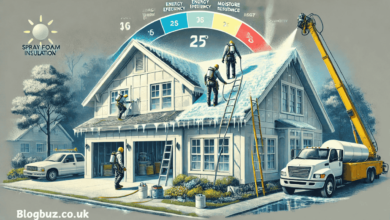The Complete Guide to Roof Installation

A solid roof is one of the most critical elements of a safe and comfortable home. Whether you’re building a new house or replacing an aging roof, understanding the roof installation process can help you make informed decisions and avoid costly mistakes. This guide walks you through everything involved—from materials and timelines to choosing the right professionals.
1. Why Roof Installation Is Important
Your roof is your home’s first line of defense against rain, wind, snow, and harsh sunlight. A poorly installed roof can result in:
- Water leaks
- Energy inefficiency
- Structural damage
- Shortened roof lifespan
Proper installation ensures long-term durability, improves your home’s energy efficiency, and increases overall property value.
2. When Is Roof Installation Necessary?
There are several situations where installing a new roof is required:
- New construction: Every new building needs a roof installed from scratch.
- Aging roof: Most asphalt shingles last 15–30 years, and materials like tile or metal may last longer.
- Severe weather damage: Hail, windstorms, and falling debris can compromise roof integrity.
- Major leaks or sagging: Water intrusion or structural issues often signal the need for a full replacement.
3. Choosing the Right Roofing Material
Your choice of material depends on budget, climate, and design preferences. Below is a breakdown of common roofing materials:
| Material | Lifespan | Pros | Cons |
| Asphalt Shingles | 15–30 years | Affordable, easy to install | Moderate durability |
| Metal Roofing | 40–70 years | Fire-resistant, energy efficient | Expensive upfront |
| Clay/Concrete Tile | 50–100 years | Stylish, extremely durable | Very heavy, needs strong structure |
| Slate | 75–100+ years | Natural look, long-lasting | High cost, difficult installation |
| Wood Shakes | 20–40 years | Rustic appearance | High maintenance, fire risk |
| Synthetic Materials | 20–50 years | Lightweight, customizable | Quality varies by brand |
4. Preparing for Roof Installation
A. Inspection and Measurements
A professional will inspect the current condition of the roof and take measurements. This includes checking:
- Decking condition
- Flashings
- Roof slope
- Gutter system
- Attic ventilation
B. Permits and Regulations
Most municipalities require permits for new roof installations. Your contractor usually handles the paperwork and ensures the job complies with building codes.
5. Step-by-Step Roof Installation Process
Step 1: Remove Old Roofing
If it’s a replacement, the old shingles or roofing material must be removed. This includes underlayment, nails, and flashings.
Step 2: Inspect the Roof Decking
Contractors will check the wood decking beneath the old roof. Any rotted or soft wood will be replaced before the new material is installed.
Step 3: Install Underlayment and Water Shield
A waterproof barrier (ice and water shield) is installed to prevent moisture from entering. A layer of underlayment (usually synthetic felt) follows, which provides a second level of protection.
Step 4: Flashing Installation
Flashing is added around chimneys, vents, skylights, and roof valleys to prevent water leaks in vulnerable areas.
Step 5: Shingle or Roofing Material Installation
This is the main visible layer. Whether you choose shingles, tiles, or metal, it will be installed in overlapping rows to create a waterproof seal.
Step 6: Ventilation System Update
Proper attic ventilation (ridge vents, soffit vents) helps control temperature and moisture buildup, extending the life of your roof.
Step 7: Final Inspection and Cleanup
After installation, the site is cleared of debris. A final inspection ensures the roof is structurally sound and all components are properly installed.
6. Common Mistakes to Avoid
Avoiding common errors during roof installation can save you significant money and stress in the long run:
- Poor ventilation: Can lead to mold, moisture problems, and premature shingle wear.
- Incorrect nailing: Too few or poorly placed nails can cause shingles to blow off.
- Inadequate flashing: Improper sealing around chimneys and vents leads to leaks.
- Low-quality materials: Saving money upfront often results in higher maintenance costs.
That’s why hiring a professional Roofing Company with a strong track record is critical.
7. How Long Does Roof Installation Take?
The average roof installation takes 1 to 3 days, depending on:
- Home size
- Roof pitch
- Weather conditions
- Material used
For example, asphalt shingles can be completed faster than tile or slate installations.
8. Cost Breakdown of Roof Installation
Roof installation costs vary based on material, labor, and roof complexity. Here’s a rough estimate:
- Asphalt shingles: $4,000 – $12,000
- Metal roof: $10,000 – $20,000
- Clay or concrete tile: $15,000 – $30,000
- Slate roof: $20,000 – $40,000+
Additional costs may include:
- Decking repairs
- Permit fees
- Gutter replacement
- Structural reinforcements
Be sure to request a detailed estimate from your Roofing Company to avoid hidden costs.
9. Roof Installation and Home Value
A new roof boosts curb appeal and increases resale value. According to remodeling studies, homeowners can recoup up to 60–70% of the cost of a new roof when selling their home.
Moreover, buyers often prefer properties with newer roofs because it means fewer upcoming maintenance costs.
10. Choosing a Reliable Roofing Company
The outcome of your roof installation largely depends on who installs it. Here are a few things to consider when selecting a Roofing Company:
- Licensing and insurance: Always verify credentials to ensure safety and accountability.
- Warranties: A good company offers both material and workmanship warranties.
- References and reviews: Look for consistent positive feedback from past clients.
- Experience: Ask how long they’ve been in business and how many roofs they’ve installed.
Be wary of companies that ask for full payment upfront or provide vague estimates.
11. Roof Maintenance Tips After Installation
Once your roof is installed, follow these tips to extend its lifespan:
- Inspect it twice a year (spring and fall)
- Clean gutters regularly
- Trim overhanging branches
- Remove moss or debris buildup
- Address minor issues (like loose shingles) promptly
Routine care ensures your roof lasts decades and continues to perform as it should.
12. Signs Your Roof Was Installed Correctly
A properly installed roof should:
- Lie flat with no lifting shingles
- Include uniform flashing and vents
- Have consistent rows of shingles or tiles
- Show no signs of sagging or bowing
- Stay leak-free during the first heavy rain
If any issues arise shortly after installation, contact the contractor immediately to inspect and address the problem.
13. Final Thoughts
Roof installation in Campbell is a significant investment—but when done right, it offers decades of protection, performance, and peace of mind. By understanding the process and partnering with a trusted professional, you can ensure a seamless experience.
Whether you’re building from the ground up or replacing an old, damaged roof, every step matters—from choosing materials to final cleanup. Take time to research your options, compare estimates, and select a team that prioritizes craftsmanship and customer satisfaction.



